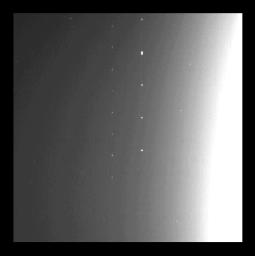
|
Galileo Optical Experiment (GOPEX)
- Click the image above for a larger view
- Full-Res JPEG (888 x 894) (41.3 kB)
- Full-Res TIFF (888 x 894) (152.7 kB)
Caption:
Two sets of laser pulses transmitted from Earth to a spacecraft over a distance of 1.4 million kilometers (870,000 miles) in a communications experiment are shown in this long-exposure image made by the Galileo spacecraft's imaging system. In the image, taken on Dec. 10, second day of the 8-day experiment, the sunlit part of the planet (west central United States) is to the right, the night side to the left. The camera was scanned from bottom to top of the frame (approximately south to north), smearing terrain features but showing individual pulses. The five larger spots in a vertical column near the pre-dawn centerline of the frame represent pulses from the U.S. Air Force Phillips Laboratory's Starfire Optical Range near Albuquerque, NM, at a pulse rate of 10 Hz. Those to the left are from the Jet Propulsion Laboratory's Table Mountain Observatory near Wrightwood, CA, at a rate of 15 Hz. Spots near the day/night terminator to the right are noise events not associated with the laser transmissions. The experiment, called GOPEX (Galileo Optical Experiment), is demonstrating a laser "uplink" from Earth to spacecraft. Laser "downlinks" may be used in the future to send large volumes of data from spacecraft to Earth.
The experiment is operated by JPL's Tracking and Data Acquisition Technology Development Office for NASA's Office of Space Communications Advanced Systems Proqram.
Cataloging Keywords:
| Name | Value | Additional Values |
|---|---|---|
| Target | Earth | |
| System | Earth | |
| Target Type | Earth | |
| Mission | Galileo | |
| Instrument Host | Galileo Orbiter | |
| Host Type | Orbiter | |
| Instrument | Solid-State Imaging (SSI) | |
| Detector | ||
| Extra Keywords | Grayscale, Mountain | |
| Acquisition Date | ||
| Release Date | 1996-02-08 | |
| Date in Caption | ||
| Image Credit | NASA/JPL | |
| Source | photojournal.jpl.nasa.gov/catalog/PIA00230 | |
| Identifier | PIA00230 | |
